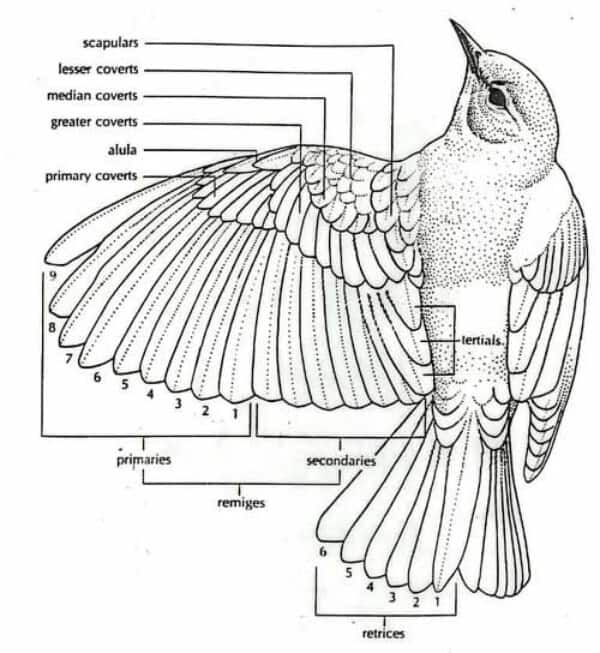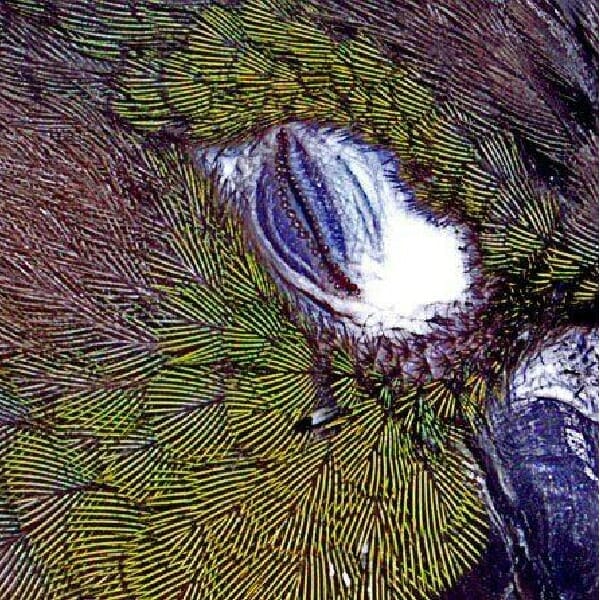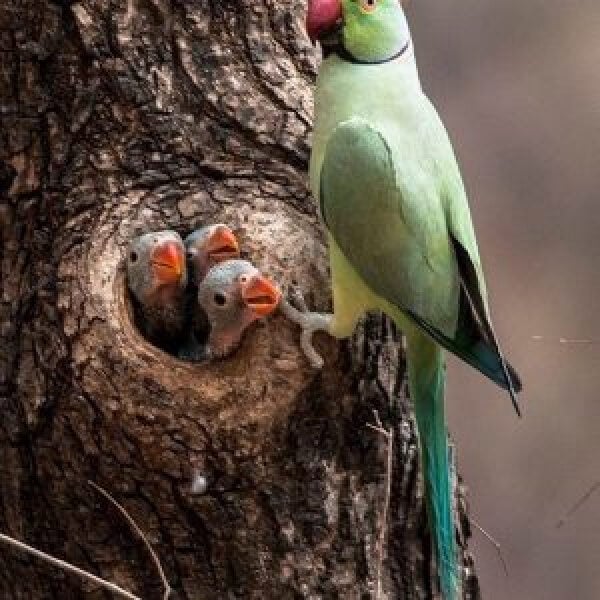Last Updated on by Mitch Rezman
What is a feather?
It’s a product of the protein known as Keratin and comes in three flavors: contour, sensory, and down feathers.
Feathers perform far more services for birds than you probably ever thought. Mature feathers are dead and can only be repaired through imping, although their initial growth is called a pin feather and is quite alive.
If a pin feather breaks a bird can suffer blood loss so the pin feather must be removed as quickly as possible.
Here’s how you can remove a pin feather:
Sometimes there’s no avoiding it, your bird’s nails haven’t been trimmed in a long time, the quick lengthened and you nick the vein in a nail.
More commonly a blood feather (growing new feathers requires fresh blood flow in the feather shaft until the feather has matured) will break.
Most times a few drops will emerge. Sometimes it’s more than you bargained for.
The best way to stop blood flow from a bleeding toenail is with a product like a styptic or blood stop powder which every bird owner should keep in their medicine chest.
The same premise applies to bloodfeathers as it does to your bird’s toenails.
If caught unprepared, corn starch, white flour, or dragging the nail on a bar of soap will work in a pinch.
I prefer hydrogen peroxide to remove any blood on the bird’s body, applied with a soft cotton washcloth or even Q-tips, although mild dish soap and water can work with patience.
Make sure your bird is secured – a light soft cotton towel is best. Be calm, talk in soothing tones, and have high-value treats available to reward good behavior.
Your bird may hoop and screech, sometimes it’s not worth the trauma to the bird to remove the stain, it’s OK, it’ll get preened out in time.
There are quill pens and Quill Office Supply both named after the hollow base of the shaft of a feather.
The upper portion of the feather is called the “rachis”.
The actual feather part is smaller barbs on top of larger barbs designed to be held together much like a zipper.
Like after parties for the rich and famous, the fluffy base of a feather is called the afterfeather.

Something I find interesting is that molting occurs symmetrically.
In other words, lose 2 feathers on the left wing, expect to see the same 2 feathers on the right wing fall very soon thereafter.
Just before the molt, the blood vessels gripping the old feather dry up which loosens the surrounding tissue.
So how do the new feathers get rid of the old feathers? They really can’t – until the old feather loosens up or is simply yanked out. The moment that happens a new feather starts to grow.
This means that if you pull out your bird’s pin feathers you’ll hasten the process of molting. In the wild, it’s hard to stop nature so a new follicle begins manufacturing a new feather even though the old one is still there and at some point may just give a little bit of a push to get rid of the old feather.
We know why birds molt but what triggers a molt is a bit more complex. DYK – Your Bird Keeps Better Time than a Swiss Watch? Your bird operates two internal clocks: the circadian clock which keeps track of the hours and a circannual clock which acts as a perpetual calendar.
We talk a lot about the
One of the key reasons is a circadian clock runs best when your bird receives the wavelengths of light that nature meant it to get.
Although sunlight appears to be white, it is formed by a full spectrum of light.
The circadian clock reacts to red light (about 640nm on the lighting spectrum).
Your birds get a different mixture of light and generally rely on artificial Full-spectrum lighting because the windows in our homes filter all the valuable UVA and UVB out of the sunlight before it reaches your bird.
Thus caged birds kept in a home will have a different molting cycle than birds kept in outdoor aviaries that are exposed to natural sunlight regularily.
Parrots In the wild are not normally slaves to their calendar clocks because they come from equatorial regions of the planet where there’s very little difference between the length of days of summer and winter (as opposed to many other species of birds).
Many birds dovetail their molting with their reproductive cycles.
If you have a bird that is broody and molting, it’s a good idea to keep a close eye on them and weigh them at least weekly.
The production of new feathers and hormonal changes divert valuable caloric resources that can put your bird at a higher risk than normal because their body is less prepared to fight illness or a bacterial infection – we learned this with our cockatiel Popcorn.
As usual, it’s hard to predict how your bird will react to a molt.
I know my reaction is to keep a small vacuum close by because it seems as though I find feathers freakin’ EVERYWHERE.
Popcorn tended to feel a bit low energy as your bird may exhibit.
Like I said before there’s a lot of energy drain on the production of the new feathers.
Some of us will let our hair (or beard) grow out.
Eventually, some trimming needs to be done to keep ourselves not looking like bush people.
For birds, the process is called preening which:
- Removes dirt
- Realigns a feather structure
- Help spread the bird’s body oils (coming from the preening “uropygial” gland) oils help waterproof feathers
- Provide social activity between birds when available
“Allopreening”, is when one bird preens another bird.
What can go wrong with feather growth?
Baby parrots who miss even half a day with their feedings may see reduced blood levels of nutrients which may create stress bars on their feathers.
Feather plucking or self-mutilation can begin as preening that can then develop into over-preening.
I have seen this happen with birds whose well-intended caged bird keepers place a fan near the bird to keep it cool in the summer.
Falling under the law of unintended consequences the fan creates a relentless tsunami of ruffled feathers they can never manage until the fan gets turned off.
I see that you’re just going to put your ceiling fan on low to keep the air moving in the room.
We hope you’ll never find out why veterinarians call ceiling fans “shredded tweet”.
Without realizing it you may expose your bird to smoke or perfume or some sort of cleaning agent that will subtly bother your bird causing them to potentially over-preening.
Keeping the air in your home moist in the winter is important too.
If you have a bird that is plucking please email [email protected] with some details.
We’d like to send you a feather plucking diagnostic form we’re working on to help a clearer path to fixing feather destruction.
The straightest line to keep feathers healthy is good nutrition which varies from bird to bird based upon their lifestyles much like you and me.
Getting the feathers wet, however you do, is important to keep down the dander with Australian birds like the big cockatoos and maintain good feather health in general.
Written by Mitch Rezman
Approved by Catherine Tobsing
Author Profile
Latest entries
 The Traveling BirdJune 26, 2025Can You Name 5 Parrot Species That Are Living Wild in the USA?
The Traveling BirdJune 26, 2025Can You Name 5 Parrot Species That Are Living Wild in the USA? Bird BehaviorJune 26, 2025How is it Parrots Are Problem Solvers Social Animals and Even Use Tools?
Bird BehaviorJune 26, 2025How is it Parrots Are Problem Solvers Social Animals and Even Use Tools? Bird & Parrot AnatomyJune 25, 2025How a Tiny Chemical Modification Makes Parrots Nature’s Living Paintings
Bird & Parrot AnatomyJune 25, 2025How a Tiny Chemical Modification Makes Parrots Nature’s Living Paintings PigeonsJune 20, 2025How Do Parrots Thrive in Cities Outside Their Native Habitats?
PigeonsJune 20, 2025How Do Parrots Thrive in Cities Outside Their Native Habitats?




